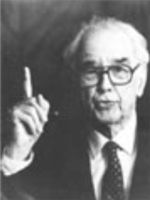 The Inventor
The Inventor
As stated in his biography, John Atanasoff had the curiosity of an inventor from an early age. Jane Smiley writes in her book, The Man Who Invented the Computer, that Atanasoff's personality exhibited many of the psychological traits that mark inventors, including self-confidence, independence, high energy, willingness to take risks, above-average intelligence, openness to experience, and preference for complexity. Atanasoff was a highly creative problem solver who often recognized ways in which machines and processes could be improved.
These characteristics exhibited themselves in his invention of the ABC, but did not end there. Atanasoff's problem finding/problem solving character extended to improving upon several wide ranging topics and objects that resulted in 32 patents during his career, some of them including:
- Method and apparatus for sweeping underwater mines (1947) (pdf)
- Method for cutting fusible fabrics (1948) (pdf)
- Cathode-ray tube (WWII-era) (pdf)
- Electronic chassis (1948) (pdf)
- Sorting system for post office or parcel business (1960) (pdf)
American National Biography notes that Atanasoff recognized the need for a universal binary computer alphabet for all human languages, an idea that anticipated ASCII and Unicode. Atanasoff also designed a new English alphabet to make learning and comprehension easier for children, thereby reducing illiteracy rates. More details about Atanasoff's experimentation and study of the creation of a new English alphabet and many of his other inventions can be found in the John Vincent Atanasoff Papers at Parks Library, Iowa State University Special Collections.
References
Smiley, Jane. The Man Who Invented the Computer. New York: Doubleday, 2010.Gustafson, John. "John Atanasoff." In American National Biography, Edited by Mark Christopher Carres. Vol. 26, p. 9-10. Oxford University Press, 2005.

